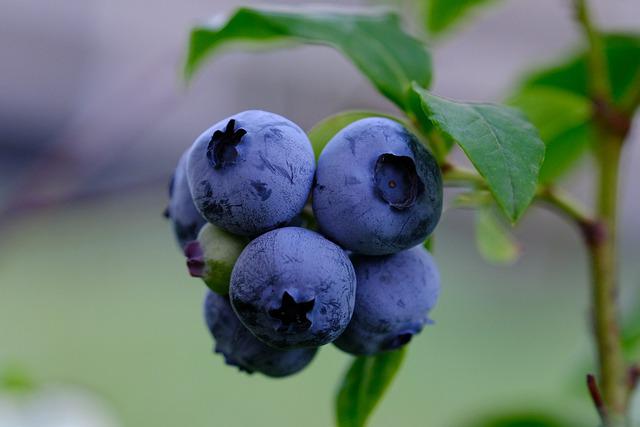Where To Plant Blueberries? A Guide On How And Where To Plant Your Blueberry Bush!

Locate your garden in a spot that receives plenty of direct sunlight and has been well-tended and well-drained. Planting away from trees is a good idea because they shade the soil and rob it of moisture. To keep the roots of blueberries wet during the growing season, it’s best to plant them in a place where water is easy to get to.
Table of Contents
Garden Site Selection and Preparation
Blueberry Hardiness Zone
- Lowbush: Hardy in zones 3 to 6. Blueberries that can withstand cold weather aren’t as productive as high bush blueberries, but they can be used as a ground cover or food forest planting.
- Half-high: Hardy in zones 3 to 5. Some blueberries that are a mix of highbush and lowbush blueberries grow about 3 to 4 feet tall. Plants like ‘Southblue’ and ‘Jubilee’ and ‘Sunshine Blue’ come in various colors. They can also withstand cold weather.
- Highbush: Hardy in zones 4 to 7. There are two types of highbush: one in the north and one in the south. Those who live in warmer places should use the Southern Highbush variety. It can’t handle cold weather very well. These shrubs can reach 7 feet tall.
- Rabbiteye: Hardy in zones 7 to 10. This blueberry can grow up to 12′ tall. It is native to the southeastern United States. As you might expect, it can handle very hot weather. Rabbiteye varieties can also handle soil that isn’t ideal.
Climate Prerequisites
Lower than -20°F can cause flower bud damage on northern highbush plants; however, half-high blueberries can tolerate temperatures as low as 35° to 45°F. If you live in an area that sees a lot of snowfall, half-high blueberries are ideal because they grow only 3 to 4 feet tall.
Preparing the Right Soil for Your Blueberry
- Blueberries thrive in acidic soil, whereas most edibles prefer a neutral pH of around 7.0. It’s important to keep the soil around your blueberries in the 4.0-5.5 range of pH.
- To get your soil to the pH you desire, you should conduct a soil test. Wait a few weeks for the test results to arrive, which will give you a detailed breakdown of your soil’s fertility and pH levels.
- The addition of acidic materials, such as pine needles or oak leaves, is commonly believed to increase the soil’s acidity around blueberry plants. In reality, these materials won’t have an immediate or long-lasting impact.
- The organic soil acidifier sulfur is needed instead. Powdered or pelletized sulfur is available. Because the powdered form creates fine, breathable dust, using it can be dangerous. Home gardeners can save money and time by using pelletized sulfur.
- Using the soil test report and the sulfur packaging information, you can determine what pH level adjustment is necessary for your particular soil. However, you should also keep in mind the type of soil you have. Thus, sand is less acidifying than clay.
- Clench a handful of soil in your fist to get an idea of its consistency. Your soil is mostly made up of sand if it breaks apart easily. You’re working with clay or silt-based soil if it forms a firm ball. It should be easy to squeeze a fistful of loamy soil with plenty of organic matter, but it should easily separate if you press on it.
- Spread sulfur over the soil where you plan to plant your blueberries once you’ve determined the soil type and the appropriate amount of amendment. Sulfur will be incorporated into the soil as you dig the hole for the planting.
- As well as being acidic, blueberries prefer soil that is well aerated, moist, and rich in organic matter.
- There are many different types of organic matter, but the most common is compost. It’s rare to find a time when composting is harmful in the garden. Although blueberries prefer a lot of organic matter, their nutritional needs are not as demanding. It’s a bad idea to use compost because it’s full of nutrients. Peat moss can be used instead. Peat moss has a low nutrient value but lasts a long time.
- Fill a bucket with peat moss, and you’re ready to go. Here, you’ll see how much peat moss Lee recommends using. I don’t think it’s necessary to be exact here. The goal here is to include as much as possible.
- Incorporate the peat moss into the planting hole’s soil. Backfill with the soil, peat moss, and sulfur mixture once the blueberry rootball is in place.
- Sulfur and peat moss will aerate the soil and add low-nutrient organic matter, lowering the soil pH.
- Don’t forget to mulch after you’ve finished planting. When it comes to blueberries, the final step of mulching is critical. Weed competition and soil drying are problems for blueberries, whose shallow root systems are vulnerable. The soil is protected from weed germination and drying air by mulching.
- Choosing the right mulch is critical. Rubber mulch or lava rock should not be used in this area. Organic materials can be used, such as sawdust or wood chips, leaves, pine needles, etc. There is a good chance that the organic matter will break down and improve the soil and your blueberry bushes over time.
- A strong start for your blueberries is ensured by providing just enough water, but not too much.
- Water an inch each week. In general, drip irrigation is the best method of watering shrubs. As a result, the plant roots will be able to soak up as much water as possible.
Spacing
Blueberries can be planted about 2 1/2 feet apart for a solid hedgerow. They can be spaced up to six feet apart and grown independently. Rows of crops should be spaced 8 to 10 feet apart based on the equipment used to mow or cultivate them.
Sun Requirement

Make sure that the place will be in full sun at least three-quarters of the day. Late in the day, blueberries can stand a little shade, but not too much.
Fertilizer and Nutritional Needs
Before or after you plant, don’t add fertilizer to the hole or the soil. Slow-release (10-10-10) fertilizer is used when blueberries show signs of a second growth spurt when the roots have grown in. Please see our fact sheet on blueberry fertilizer practices for more information. Blueberry plants use calcium ammonium nitrate or urea ammonium nitrate to get the nitrogen they need to grow.
Common in blueberry gardens where the pH level is above 6, iron chlorosis can cause the plants to turn yellow. This means that the plant can’t get enough iron from the soil because the pH level is too high. Symptoms of Iron chlorosis include slow growth, yellowing leaves, early defoliation, and weak plants. In the spring, yellowing foliage can signify that the pH level in the soil is too high. The same thing can happen in the summer if the soil temperature is too high. If the soil pH hasn’t been checked in three years, it should be. Then, it should be changed as needed. If the symptoms start later in the season, make sure that the mulch layer is about 3 inches thick. You can try to spray the foliage with an iron-chelated formulation from your local garden store as a short-term fix.
